A couple of days before Christmas I received a call that made me drop the wrapping paper, abandon the Christmas lists and head to a beach at Phillip Island – Hooded Plover chicks had hatched! For the past few years I’ve been hoping to document the journey of a family of hoodie chicks from hatching to fledging.
Hooded Plover nest
Canon 7DII, 1/400, f/18, ISO 400
Let’s start at the beginning, hoodie nests are hard to find, even when you’re standing just a couple of metres from one. There is a nest in the image above but even though I’ve narrowed the area down dramatically it’s still not easy to spot. It would be easy to step on it accidentally, or for a dog to step on it accidentally, or for a fat-bike rider to crush it, accidentally.
It was a miracle that the chicks I was rushing to see had hatched, the ranger mentioned that he’d seen footprints all around the nest, despite the symbolic ‘protective’ fencing urging people to ‘Keep Clear’ and to walk along water’s edge.
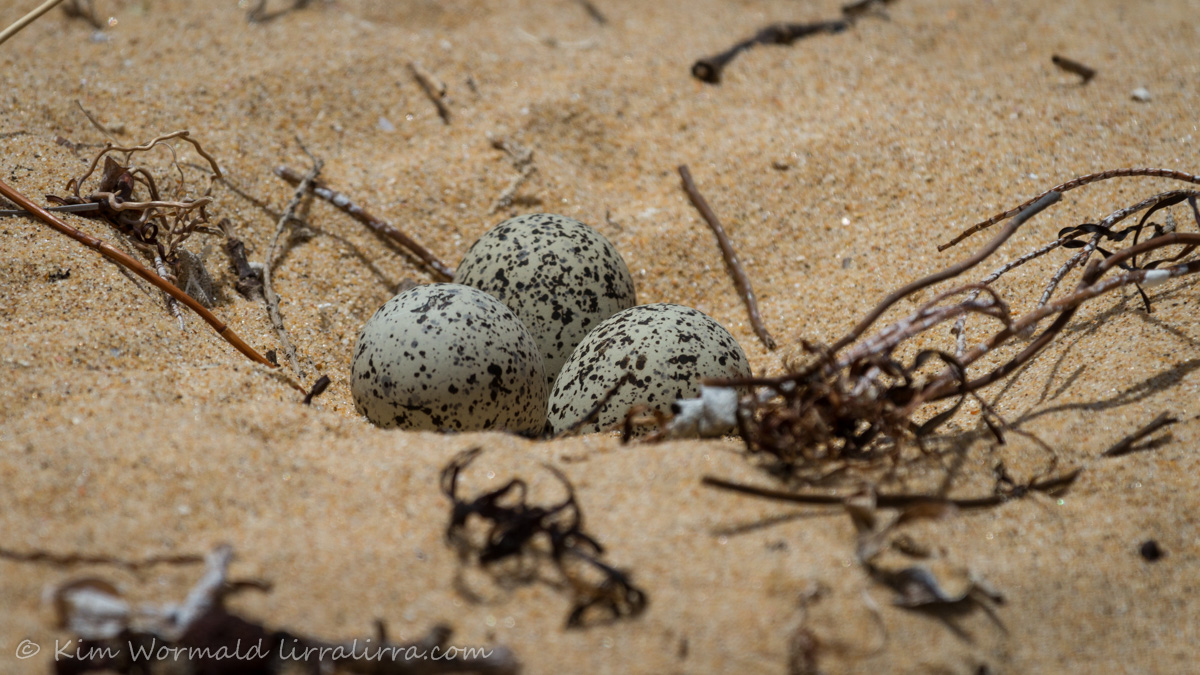
Hooded Plover eggs
Canon 7D, 1/1000, f/8, ISO 100
Here’s a close up of a nest I took a while ago while helping to put up protective fencing. The mottled eggs are tiny, like large marbles, and even though the ranger pointed at the nest it took me quite a while to see it.
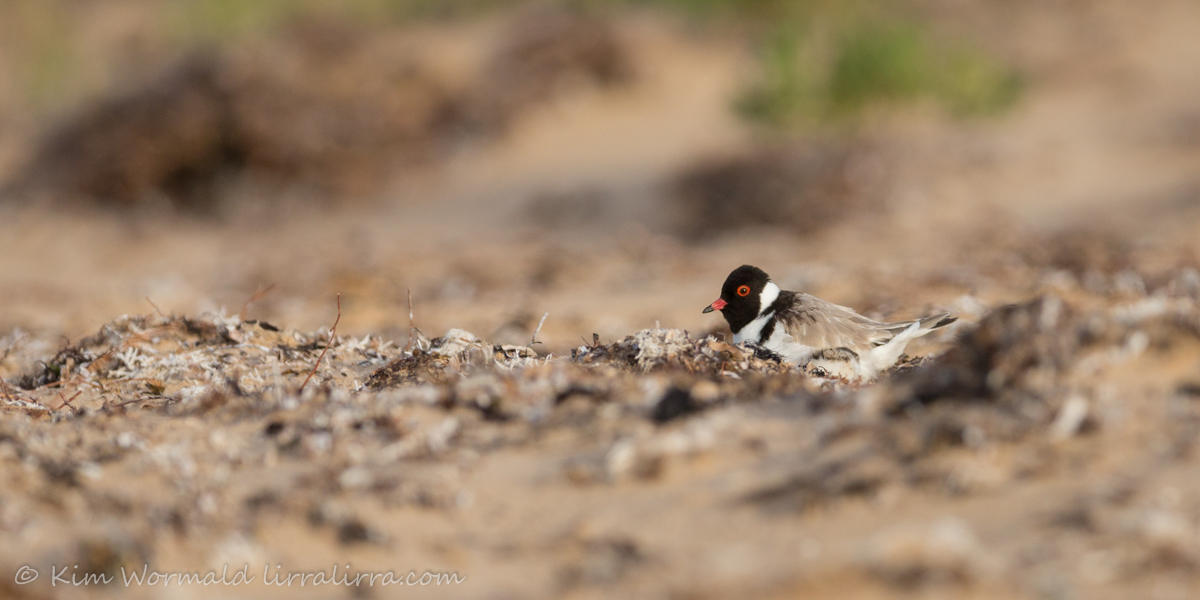
Adult Hooded Plover (Thinornis rubricollis rubricollis) with a day old chick
Canon 5DIII, 1/1250, f/6.3, ISO 400
My first glimpse of one of the new chicks was seeing it snuggled against a parent bird, a tiny fluffy bundle that has to forage for itself from the time it hatched. Yep, that’s right, they forage for themselves from the very beginning. They don’t have the luxury of sitting in a nest waiting for food to be brought to them, instead they need to get to the water’s edge and hunt for the tiny arthropods and other critters that make up their diet. That is remarkable, truly remarkable, and fraught with many dangers.
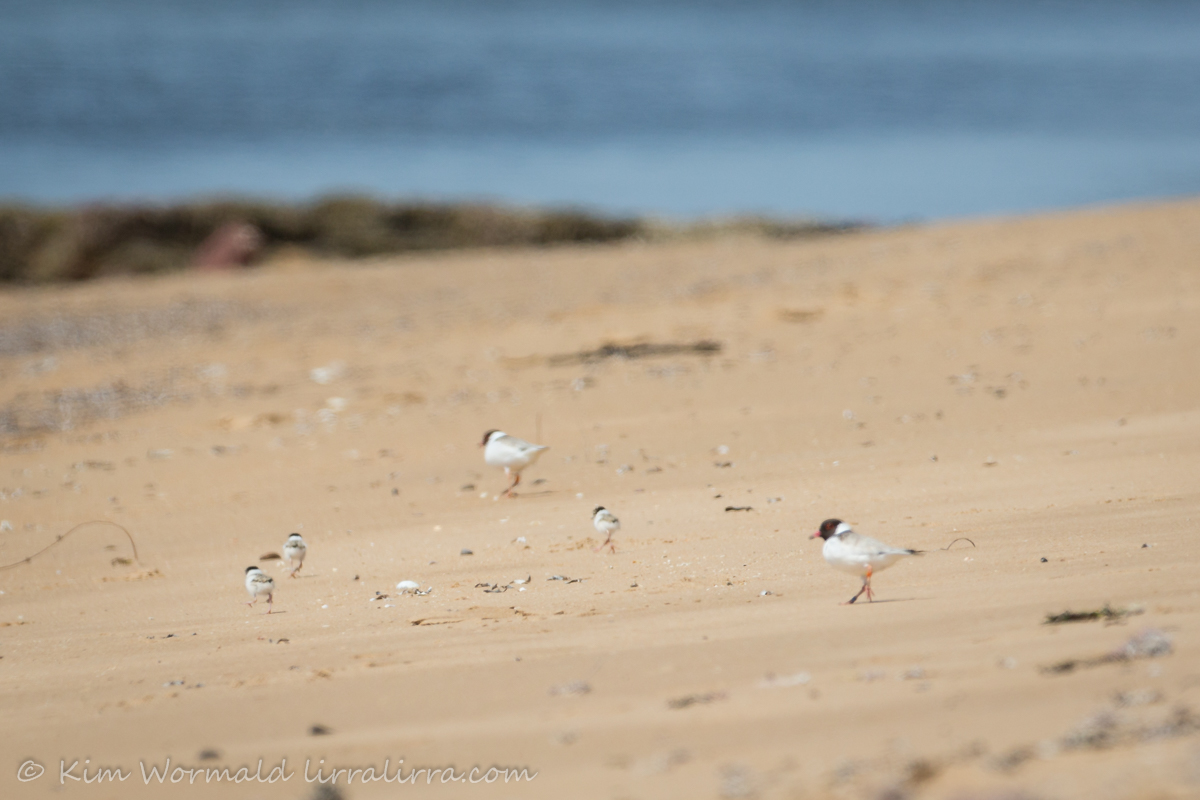
Hooded Plover family (Thinornis rubricollis rubricollis) – two-day old chicks
Canon 5DIII, 1/1000, f/8, ISO 400
I have many images of Hooded Plovers that are better than this one but this post is about this family and this was the clearest image I managed to capture of them as a group. The parent birds are remarkable too. Over the Christmas period holiday-makers pepper the beach, walking, jogging, paddling, swimming, with their children, their buckets and spades, their fishing rods, their kites, their dogs and now the added concern of fat-bikes – the hoodie parents react to all of these disturbances with concern. They need to get to the water’s edge to forage but they can’t risk being stranded there when people, dogs or bikes turn up. So they are wary, super wary. They stay in the dunes, watching the beach users and keeping their babies stashed and hidden, and unable to seek shelter or forage.
The hatchlings aren’t able to fly for 35 long days, during that time they are incredibly vulnerable.
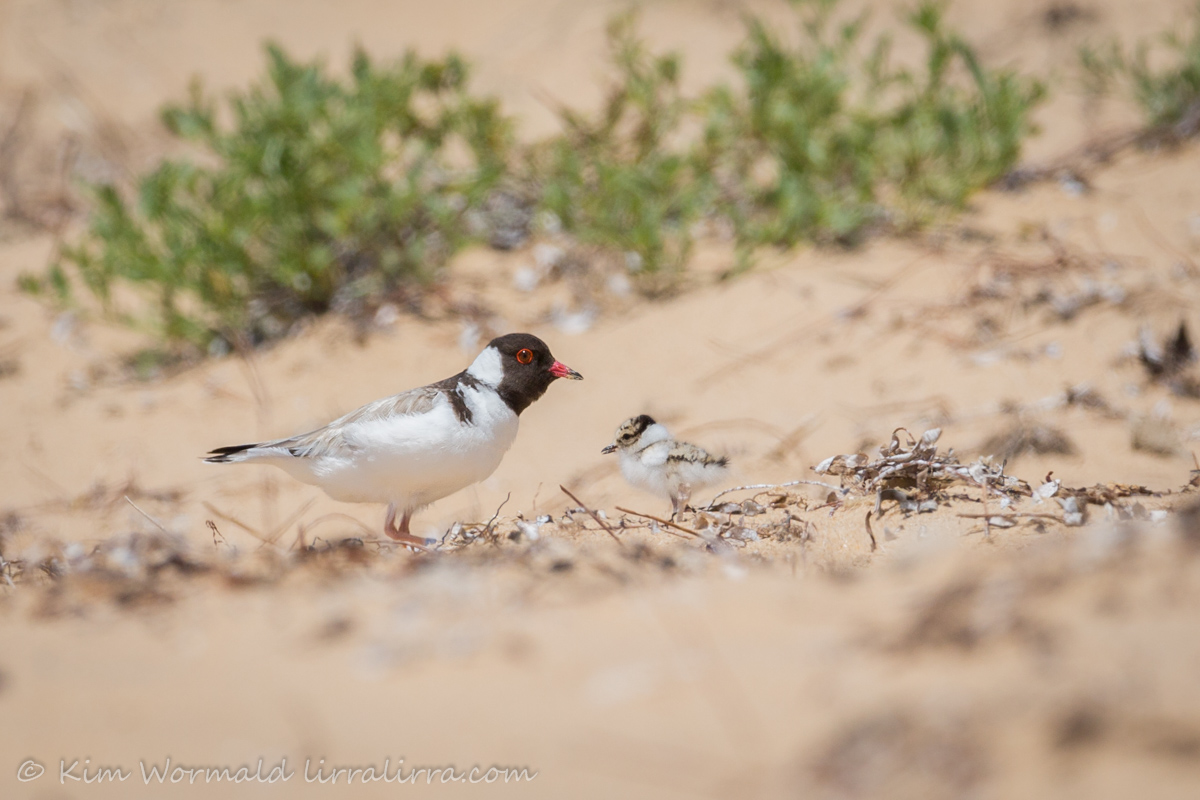
Adult Hooded Plover (Thinornis rubricollis rubricollis) with two-day old chick
Canon 5DIII, 1/1000, f/10, ISO 400
I was a long way from the hoodies, hidden beneath a fabric hide, when I took the heavily cropped image above. What tiny wings and exquisite markings, what a little beauty.
Hidden three-day old Hooded Plover chick
Canon 5DIII, 1/1000, f/10, ISO 400
Often the chicks hide by flattening themselves against the sand where they blend perfectly with the background and are virtually impossible to see. Sometimes they hide among the tiny plants at the edge of the dunes. The chick above is looking at you, can you see it? Would you know where it’s safe to tread?
Adult Hooded Plover with three three-day old chicks
Canon 5DIII, 1/1600, f/7.1, ISO 800
In the image above all three little chicks are near the parent bird, one is nestled beneath the adult on the right-hand side. The structure on the left is a hoodie shelter that was specially made by local primary school students.
I spoke with dozens of people on the beach and a few of them were lucky enough to see the chicks; it was lovely to see the delight on their faces when they spotted the tiny bundles of fluffiness. Most didn’t see the chicks, or even the adult birds. The adult birds will sometimes respond to a threat with ‘leading’ behaviour by running along the water’s edge, pretending to forage in order to lead the threat away. Sue (a Hoodie Watch Volunteer) and I watched the parent birds running along just in front of a pair of joggers, anxiously leading the joggers away from their hidden babies. The adult hoodies flew when the joggers were just a few metres from them and the fascinating thing is that at no point did the joggers notice the hoodies, not even when they took flight. And yet the handful of people who believe their dogs should be allowed to run off-lead, and the fat-bike riders (and the officials who approved their use on hoodie beaches) somehow believe they’d be able to see the hidden babies.
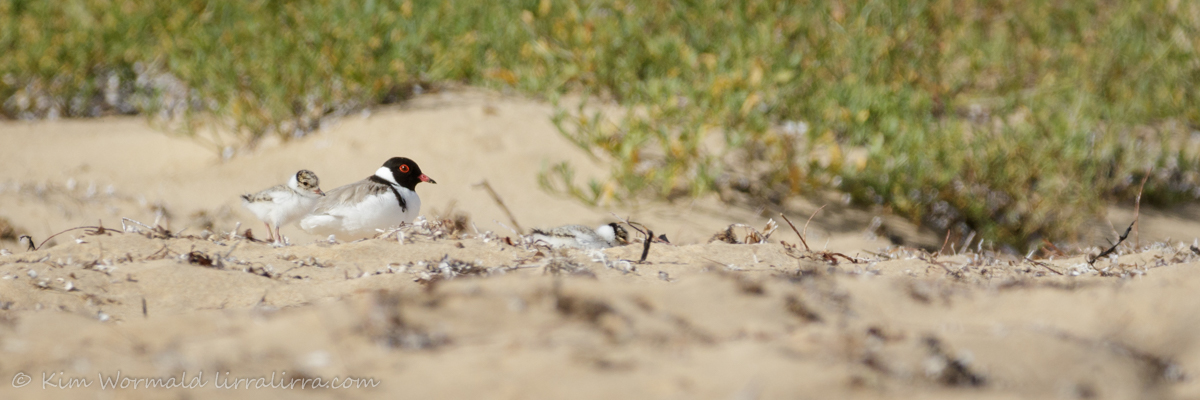
Adult Hooded Plover with two eleven-day old chicks
Canon 5DIII, 1/1600, f/7.1, ISO 400
One of the three chicks went missing at the end of its first week. We’re not sure what happened but there was a crazy amount of disturbance on the beach and the hoodies were unable to get to the water’s edge as often as they should have. They often run out of the symbolically ‘protective’ fencing but on one of the days they ran a long way and settled near some rocks at the far end of the beach where there were numerous people and dogs. We were very worried for them. The wonderful volunteers quickly erected ropes around the area to let people know. If only the hoodies could read they’d know to stay in the area sectioned off by the ropes, but those areas are not large enough. It’s sad when fat-bike riders hop straight back on their bikes at the end of the ropes, which is what has been recommended, but which won’t help the hoodies if they’ve ventured beyond the refuge, which off course they often do as they need several hundred metres of beach in order to survive. If chicks are stashed directly in front of joggers there’s about a 25% chance that a chick will be crushed; if they are stashed directly in front of a fat-bike (so called because of the extra wide tyres) there’s a 100% chance that a chick will be crushed.
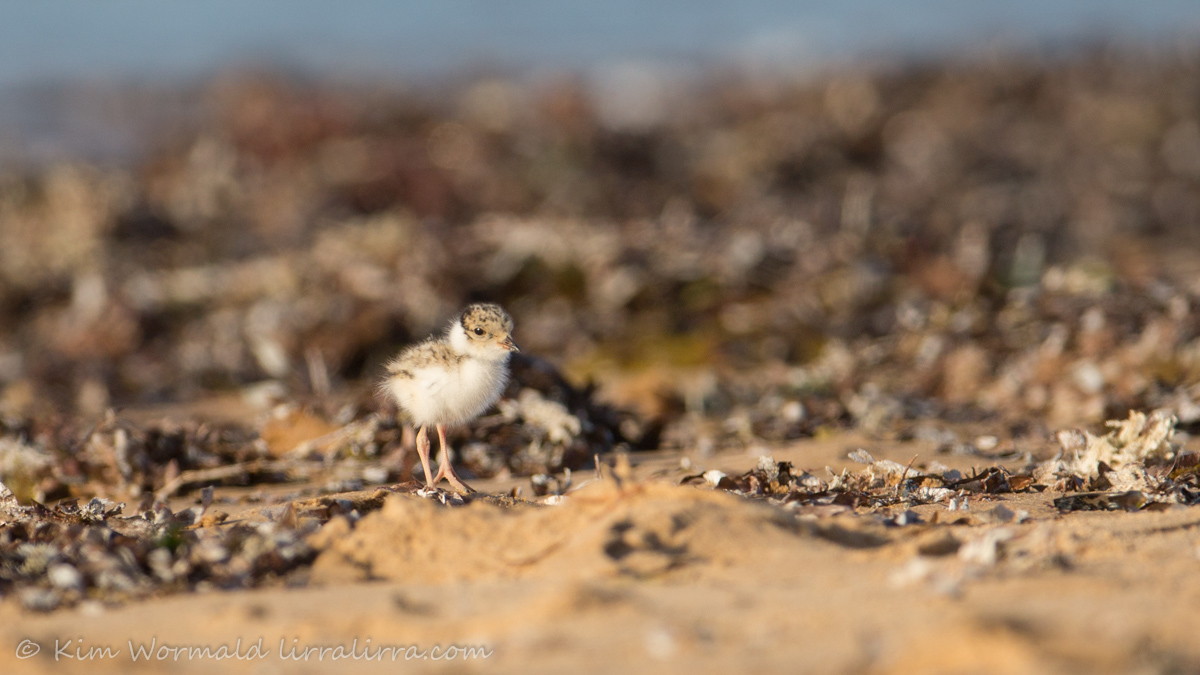
Hooded Plover chick from an earlier clutch on a different island beach
Canon 5DII, 1/1250, f/6.3, ISO 400
Another chick went missing half way through its second week.
People were seen taking short-cuts through the middle of the refuge to get to the pathway. Dogs were seen on the beach outside of the permitted 6 hours per day, dogs were seen off-leash which is not permitted at any time around the refuge. People set up camp in front of the refuge, spreading their towels, setting up their fishing rods, ambling around the rock pools – and the volunteers patiently reminded them to keep the area clear, to put their dogs on-lead, to leave the area available for the hoodies to forage – and virtually everyone was grateful for the advice.
And then came the morning when no chick was visible. The parents were behaving as though it was still there, looking towards the dunes where we hoped the chick was stashed, but we didn’t see it. We didn’t see it in the afternoon either, or the evening, or the following morning. And then the adult birds flew around the point and we knew that the third chick had not survived. The adult birds had worked so hard to raise their babies. For their four weeks of incubating the eggs, including running down to the water on hot days to dampen their tummy feathers to keep the eggs at a safe temperature, and for their two weeks of assiduously guarding their babies they had nothing to show for it. And those three little chicks lost the chance to help their species to survive in a world that continually adds more dangers.
Masked Lapwing
Canon 5DIII, 1/400, f/5.6, ISO 1600
During the chicks’ short lives I spoke with dozens of people on the beach, most of them were delightful. Several were surprised to realise we were helping protect tiny Hooded Plovers rather than the larger Masked Lapwing (aka the Spur-winged Plover) pictured above. Masked Lapwings are much larger birds which are often seen around the island. I guess it’s easier to imagine these are the birds being protected rather than the ‘invisible’ birds that take more effort to see. Lapwings often visit the beaches and can be seen around the Hooded Plover refuges but they prefer to set up their nests in the middle of mown, grassy areas. Their hatchlings also need to feed themselves within a few hours of hatching but unlike the gentle hoodies the lapwings vigorously defend their downy babies by swooping people and potential predators. They are noisy birds with a loud ‘kekekekekekekekek’ call that they often make in flight, and even at night, whereas the hoodies use a quiet ‘peep’ that is difficult to hear unless the beach is deserted and the water is calm.
Many beach goers went out of their way to walk on the pathway behind the beach so as not to disturb the hoodies, thank you. Many turned around and walked back the way they’d come rather than risk keeping the birds from the water’s edge, thank you. One raced along the beach to let people with off-lead dogs know to use a leash in the area, thank you. Many expressed great concern that more isn’t being done to help the hoodies, and many were especially concerned that people are allowed to have dogs in the refuge area at all, thank you. At least one wrote to the Bass Coast Shire Council asking for more to be done to protect the hoodies, thank you.
The Federal Government recently categorised Phillip Island’s Hooded Plovers as ‘endangered’. There are currently 17 pairs on the island and between them this breeding season they have created 34 nests and laid 77 eggs. Of those eggs only 29 have survived long enough to hatch, of the 29 chicks only 6 have fledged. Some of the losses may have been caused by natural predators such as ravens, gulls or raptors but even those losses have a potential human component; the numbers of ravens and gulls on the island has increased in-line with the number of people. And, more importantly, the little hoodies can’t hope to protect their chicks from all dangers so while they’re anxiously monitoring the people and dogs on the beach it’s harder for them to keep an eye on predators in the sky – the poor birds must be exhausted.
A similar species in the United States, the Piping Plover, gets priority treatment during the breeding season. I searched for ‘piping plover beach closure’ and randomly chose a site which talked about the 7 miles (11 km) of beach that is closed to vehicles (including bikes?), pets and kites from March to September, right through the northern summer. Wow. Even closing 500m stretches of hoodie beaches to bikes, pets and kites (which the hoodies presume are raptors), once a nesting site has been established, would give our hoodies a chance to successfully raise their clutches.
I’ve written this post now in the hope that we can help protect the eight nests currently active on the island, and any hoodie nests in other areas of Victoria, New South Wales and South Australia. Please spread the word and be mindful if you are visiting hoodie beaches, and carefully follow advice given on signage or by the awesome volunteers, rangers and by-laws officers . If you’d like to join the team and help the hoodies contact me at kim@lirralirra.com and I will pass your details to Sue. Even if you only have a few hours to spare they could be the critical hours that make a difference.
Happy birding, Kim
PS If you’d like to see clearer images of beautiful hoodie chicks that survived long enough to fledge check out In love with hoodie chicks and Hooded Plover chicks
~ Thank you for visiting and commenting
~ If you would like a weekly email letting you know that lirralirra has been updated please use the ‘subscribe’ box above right
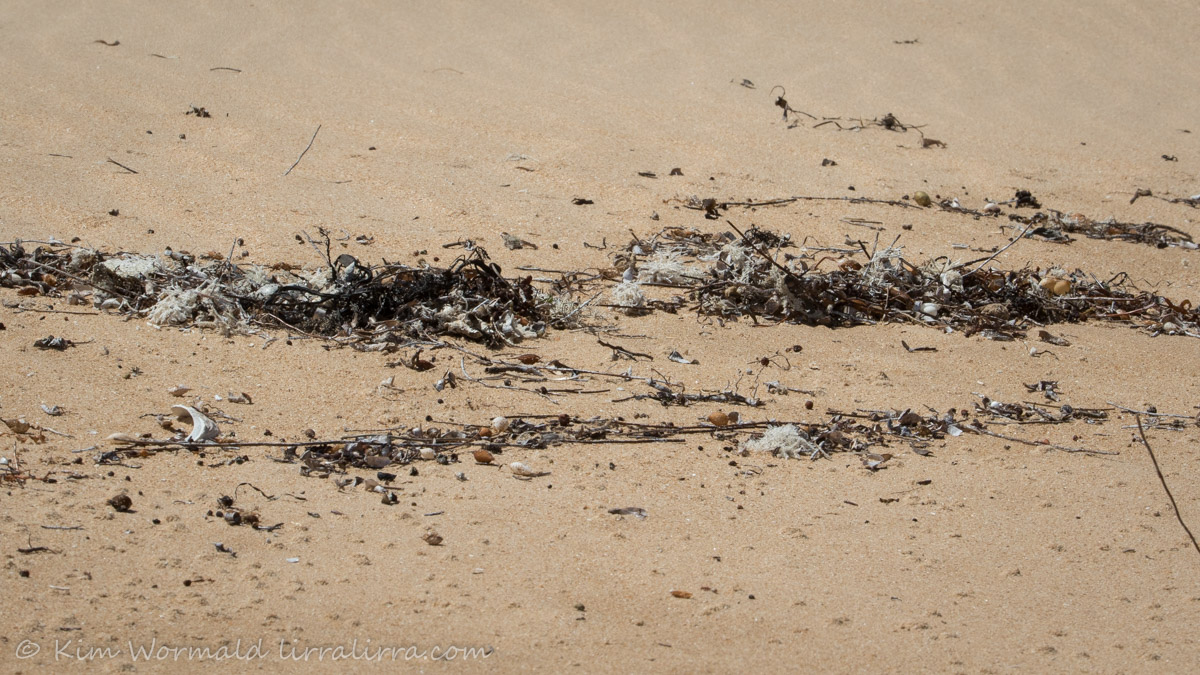

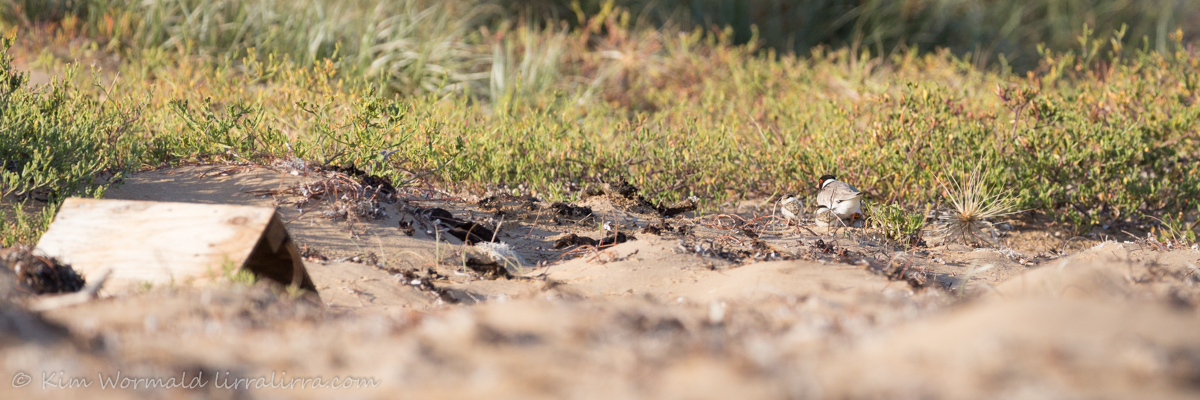
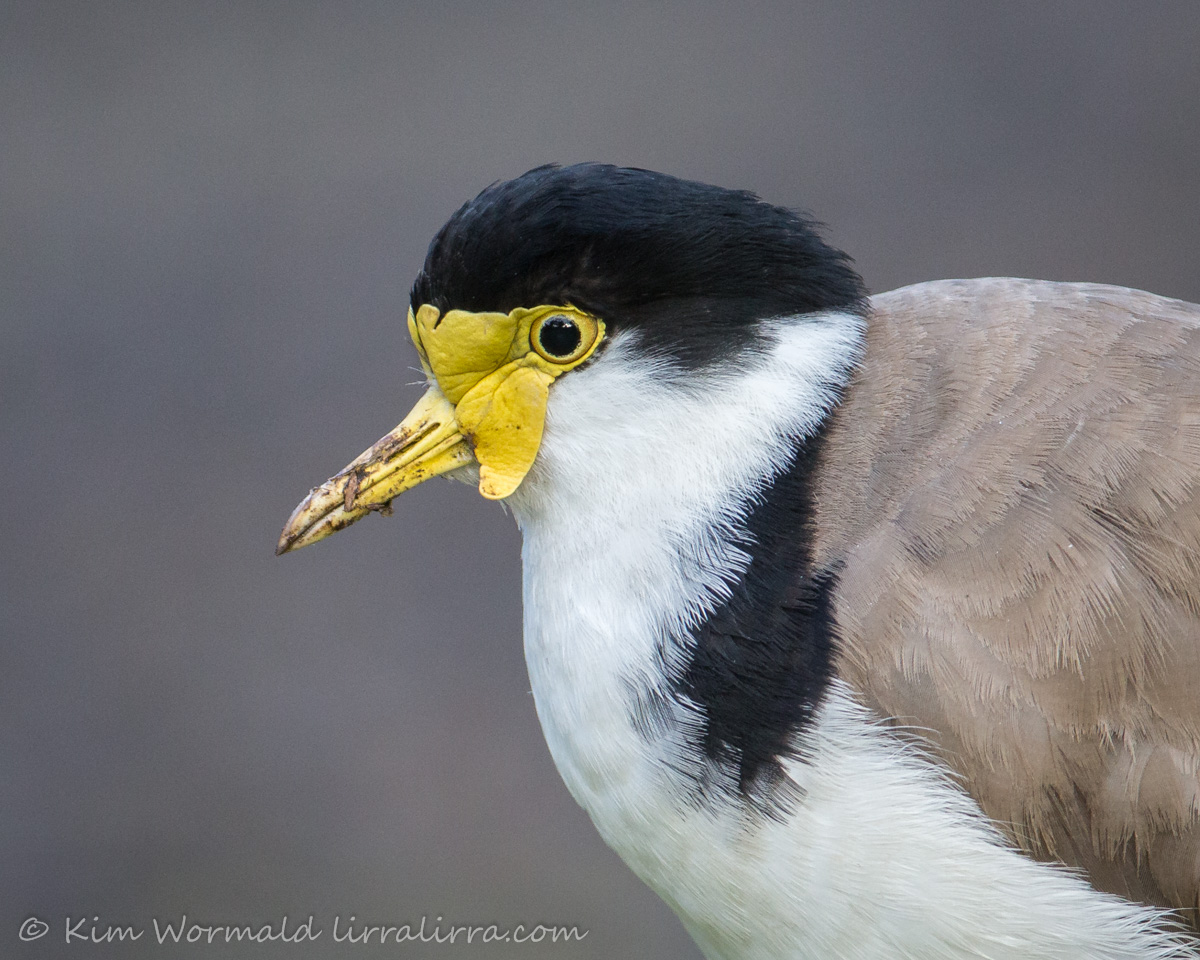

This is a late comment added post-New Year’s Eve fire in Mallacoota, far east Victoria. We have a pair of Hooded Plovers that successfully sat on their nest thru the fire storm and hatched 3 chicks. 2 have survived thus far and volunteers and caring locals are monitoring hoping that they successfully fledge. Yes, there are the usual predator dangers (birds of prey, dingoes, foxes, stomping by deer etc) but the summer beach visitation by humans is seriously diminished this year because Mallacoota was cut off by fire then roads closed post-fire for weeks after. Tourists were evacuated and locals preoccupied as they dealt with fire and its aftermath.
So nature dealt us a fierce blow but dealt the Hoodies a much needed lending hand.
We’re hoping those 2 little remaining miracles can survive to fledging.
Oh Alison, thank you so much for sharing this story of hope for the hoodies after the horrors of the fire storm and its aftermath. I hope the miracle chicks stay safe and are close to fledgling. My heartfelt thanks to all the volunteers and caring locals who are monitoring the little family.
PS And closed to dogs and the other things that mean they can’t survive as well
I don’t understand why their beach can’t be closed to people like they are in the USA. I hope I get to see them one day especially if they are in a safe place.
I agree with you 100% Tess. There are plenty of other beaches available to people and dogs. It’s a shame the hoodies breed during the summer holidays which makes things even harder for them.
Terribly sad that the precious little ones didn’t make it. Thank you so much to the volunteers.
It was really distressing Eleanor. I hope they have more luck this year. Thank you for caring.
[…] PS for more images of hoodies and a wealth of information please check a previous post 3, 2, 1, 0 sadness […]
This is probably a strange suggestion but could you make posters of your images and have them hanging from the roped off areas? You could even have one sentence on them explaining some of the things that Hayley mentioned people might not be aware of like ‘this is an active nest, even if you can’t see it’ – with a picture of a baby hoodie… Something like that might be effective for educating people in just a glance.
I think it’s a great idea to have a comment like ‘this is an active nest, even if you can’t see it’ – and a baby hoodie pic would have to add to the impact. The volunteers currently do a great job putting up signage and images at pathways to the beach and at the ends of the refuges. We’d have to be careful not to put signs in places that would encourage people to walk up to the ropes, or dawdle in the refuge area. I’ll mention your suggestion to the volunteers, thank you.
I agree re making it something that people can see from a distance. I was thinking big lettering and a short sentence with a cute bird. Even one that says ‘watch your step’ maybe.
I’m getting a bit carried away but I’m imagining a picture of a chick with a 50 cent piece or something superimposed next to it to show scale.
I’ll pass that on, Alyssa. The ‘scale’ idea is a good one, a chick could sit on a 50 cent piece. Thank you for caring.
Now I’m getting a bit carried away but thinking along the lines of ‘you can’t see them but they’re watching you’
I have seen the roped off areas at beaches for Hooded Plovers.
This photo journey really helps understand why they are so precariously holding on.
In the roped off area we see near Apollo Bay, I’d assumed the nest had been left long ago – but no, their nests can look like discarded seaweed, or even dips in the sand. And the reason I have never seen one is that they are so, so, incredibly tiny.
So I have learnt two things, one that their nests don’t look like a typical birds nest, and secondly, that they need to reach the water to feed. And if their path is interrupted by too much people traffic along the shore-line, the chicks spend their whole time hiding in the dunes and don’t get the chance to eat.
When I was working on this post I was thinking it would be worth the effort if just one person learned more about the hoodies and their chicks – thank you for letting me know it’s helped your understanding – that makes me happy! And, btw, sometimes there’s not even a random pile of seaweed, often their nest is just a tiny scrape in the sand.
Your comment has made me think about the issue from the point of view of visitors to the hoodie beaches; many are holiday makers who probably assume the same as you did, that the nesting period has finished, when in fact the areas are only roped off when there is an active nest on the beach. And you are right about why you’ve never seen one!
Your comments are super helpful Hayley, and greatly appreciated.
I like your pictures.
Thank you sweet Georgia!
Kim, great story as well as great photos. I find showing or giving people the comparison post card really useful to educate them about the difference between the two species.
Thanks Elizabeth. I haven’t seen the comparison postcards for ages, I didn’t realise they were still around. Some of the people I spoke to about the lapwings had walked past comparison signs.
A great post Kim.
Once again it illustrates “it’s all about humans” – the most destructive species on the planet. Having said that,thanks to the humans who do care and contribute so much to the safety of these little birds.
Thank goodness for all the wonderful people out there doing good things!
Kim this article has made me well up, it’s devastating that they didn’t survive. Having been on the beach with you whilst you were volunteering when we saw them and I made sure that I only walked in your footprints as to ensure I didn’t accidentally tread on one I know how tiny and precious they are. Thank you to you, Sue and the amazing other volunteers as I hope that the hoodie species survive so that I may see them again when I’m next over and to show them to Joseph as well who would love to see them and would put on the jacket and tell people to turn around and put dogs on the lead without a second thought. Let’s hope that through lirralirra and volunteers like you the government and people learn how precious these tiny birds are so they can be around for many more generations xx
I look forward to enlisting Joseph as a volunteer – how great would that be! I wonder if it’s important for people to actually see the hoodies to understand how tiny and vulnerable they are. It was good sharing that time with you on the beach, and rescuing the baby lapwing from the traffic. I’m still amazing that the parents didn’t swoop us, they must have understood we were helping.
Closing the beachside seems like such an obvious thing to do. I hope the council will do the right thing by these little babies in the next breeding session. Good for you and the other volunteers.
I hope the council does the right thing too, Tamsin, and hopefully soon.
I am so grateful for the work that you and the other volunteers do.
And in tears.
There are volunteers on the island who do so much for the hoodies that I don’t know how they find time for sleep – wonderful people.
Hi Kim
Great photo-essay and an all too familiar sad ending for the Hoodies that just don’t know or seem to learn to keep away from our (should read their..) busy beaches. Not a great example of sharing our world’s limited and precious natural resources.
On a much brighter note, I visited Bruny Island Tas early in this New Year, walked a beach near the “township’ of Adventure Bay and spent half an hour in close proximity to three pairs of adult Hoodies with x9 juveniles between them…..very stoked to do so. The beach theses birds were on was near the small township, was sign posted, and had temporary fences……..but the best feature was a poster on the beach from the local Primary School….our future.
Thanks for the post.
Cheers AB
Thanks for your comments AB. How brilliant to have seen so many hoodies, and all of their chicks. I think the Primary School poster sounds brilliant! If you took a photograph of it could you send it to me; the primary school teacher in me is interested in following up on the idea.
Thank-you so much for the effort you and the other volunteers put into protecting these amazing and very small birds, Kim!
I saw some recently across the water on the other bank at the Altona Coastal Park and I know how tiny they are. I really couldn’t get a decent shot from where I was but was thrilled to see these and another tiny wader as well. Not sure what it was.
I think there are some that nest on the Bellarine Peninsula too around Ocean Grove as I’ve seen signs on the beach there. Dogs are a big problem and when we were at Altona toward the Laverton Creek end, several people took their dogs out onto the sand bank/islet and were totally unaware of the signs telling them to keep them on leashes to protect the birds there. Some even encouraged their dog to chase the birds away!
I am going to share this post so others may become aware of this problem and hopefully educate more people to take care of our special little native birds!
Many thanks for sharing the post, Kim, much appreciated. Once you’ve seen the little lovelies I think you’re hooked, they are stunning little birds. Maybe the other tiny waders you saw were Red-necked Stints, or if it was just one maybe a Red-capped Plover or a dotterel. So sad to hear about the dog owners encouraging their dogs to chase birds, unbelievable. I’m sure most of those people wouldn’t dream of crushing a beautiful little chick in their hands, they just don’t understand. Education is the key.
Oh no! This is so devastating, particularly after all the effort from the parents and volunteers. It’s heartbreaking but I’m very thankful for you, Sue and the other volunteers who give these lovely little birds a chance. I dread to think how minute the population of hoodies would be without such dedicated people watching over them.
Thank you Alyssa. Hopefully things will get better for them soon.